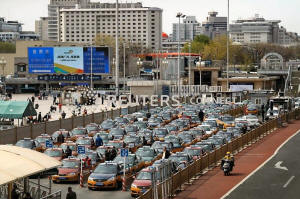China has fewer new coronavirus infections, starts posting tally of
symptom-free cases
 Send a link to a friend
Send a link to a friend
 [April 01, 2020]
BEIJING (Reuters) - China reported
dwindling new infections on Wednesday in the global coronavirus pandemic
and started to publish the daily change in cases that are free of
symptoms, although the latter could complicate the picture of trends in
the disease. [April 01, 2020]
BEIJING (Reuters) - China reported
dwindling new infections on Wednesday in the global coronavirus pandemic
and started to publish the daily change in cases that are free of
symptoms, although the latter could complicate the picture of trends in
the disease.
Almost all of Tuesday's 36 new cases involved arrivals from overseas,
the National Health Commission said, down from 48 a day earlier, and
taking total infections to 81,554.
But that figure excludes 130 new sufferers of the highly contagious
disease who do not show symptoms, statistics from the health authority
showed.
Some other countries include cases that test positive for the virus but
display no symptoms in the tally of confirmed cases, in line with advice
from the World Health Organization.
China must "build a solid line of defense against the risks of overseas
epidemic", and allow no loopholes, President Xi Jinping said in comments
published on Wednesday.
In his remarks during a visit to the eastern province of Zhejiang, Xi
also urged better management of symptom-free cases.

Users of Chinese social media have expressed fear that carriers with no
symptoms could be spreading the virus unknowingly, especially as
authorities ease curbs on travel for previous hotspots in the epidemic,
now that infections have subsided.
Last week, WHO epidemiologist Maria van Kerkhove told a conference in
Geneva that symptomatic patients were the main drivers of transmission
in the majority of cases, while most of those classified as asymptomatic
developed symptoms a few days after diagnosis.
But China has now decided to devote greater screening to asymptomatic
sufferers and those in contact with them.
By Tuesday, 1,367 asymptomatic cases were under observation, down from
1,541 the previous day, the National Health Commission said.
Seven deaths from the virus were reported on Tuesday, up from just one
the day before. All but one were in the central province of Hubei, where
the outbreak began late last year.
A single new local infection was reported in the southern province of
Guangdong.
Although the tally of imported cases, at 806, is just a small fraction
of overall cases, authorities fearing a second wave of infection have
barred entry to most foreigners and ordered tougher checks on citizens
returning from abroad.
[to top of second column]
|

Taxis line up outside Beijing Railway Station as the spread of
coronavirus disease (COVID-19) continues in Beijing, April 1, 2020.
REUTERS/Thomas Peter

HUBEI AND WUHAN RESURGENCE
Life in Wuhan, the capital of Hubei province, the epicenter of the
now global pandemic, is slowly returning to normal as the government
eases a more than two-month-long lockdown.
In Hubei, 93.8% of companies have resumed operation while in Wuhan
85.4% are back in business, Hubei's National Development and Reform
Commissions (NDRC) vice director Xie Gaobo said at a news briefing
on Wednesday.
Xie added that for the next stage, the focus be on studying measures
that can help companies return to full capacity. Business surveys
this week showed domestic demand remains weak and export orders are
plunging as more countries impose strict lockdowns and other
anti-virus measures.
Meanwhile, China also is taking further steps to support hard hit
small and medium enterprises (SMEs).
The bar for loan applications from small start-ups will be lowered,
the vice president of People’s Bank of China (PBOC) Wuhan branch
Wang Bing said, adding that these enterprises can apply for up to 3
million yuan ($423,000) of credit.
"For virus-hit SMEs, repayment on loans and interests can be delayed
till June 30," Wang added.
As of March 31, banks in Hubei have issued 30.299 billion yuan in
cheap loans to such companies, he said.
Hubei, which will see 450,000 fresh graduates this year, has the
"relatively heavy" task of safeguarding employment, the vice
director of Hubei's Department of Education, Zhang Jinyuan, said.

Zhang added that online recruitment was being rolled out,
state-owned enterprises and SMEs were being encouraged to hire more
Hubei graduates and rules were being drafted to attract more
graduates into the army.
(Reporting by Gabriel Crossley, Cheng Leng and Shivani Singh;
additional reporting by Josh Horwitz; Editing by Kim Coghill and
Simon Cameron-Moore)
[© 2020 Thomson Reuters. All rights
reserved.] Copyright 2020 Reuters. All rights reserved. This material may not be published,
broadcast, rewritten or redistributed.
Thompson Reuters is solely responsible for this content. |